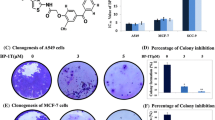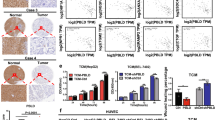Abstract
Hypoxia-inducible factors (HIFs) and STAT-3 play essential roles in angiogenesis. HIF-1α and STAT-3 are clients of the heat shock protein 90 (HSP90). We hypothesized that ganetespib, a potent HSP90 inhibitor, would disrupt angiogenesis in colorectal cancer (CRC) through inhibition of HIF-1α and STAT-3. CRC cell lines (HCT116 and HT29) were used in all the experiments. Egg CAM and HUVEC assays revealed decreased angiogenesis in ganetespib treated cell lines. Ganetespib inhibited matrigel plug vascularization and tumor growth of xenografts. Significant inhibition of PDGFA, FGF2, Ang-1, Ang-2, TGFβ1, VEGF, HIF-1α and STAT-3 expression was observed in both cell lines treated ganetespib. HIF-1α overexpression resulted in the increase VEGF and STAT-3 expression and this was inhibited by ganetespib. HIF-1α knockdown inhibited VEGF and STAT-3 expression. STAT-3 knockdown inhibited VEGF but not HIF-1α expression. HSP90, STAT-3 and VEGF expression was significantly higher in CRC compared to adjacent normal tissue. Significant downregulation of PDGFA, FGF2, Ang-1, Ang-2, TGFβ1, VEGF, STAT-3 and HIF-1α mRNA was observed in the post ganetespib treatment tumor samples from patients with rectal cancer. These results collectively suggest that inhibition of HSP90 is a promising antiangiogenic strategy in CRC. HSP90 angiogenic effects are mediated through HIF-1α and STAT-3.









Similar content being viewed by others
References
Siegel R, Naishadham D, Jemal A (2012) Cancer statistics, 2012. CA Cancer J Clin 62(1):10–29. doi:10.3322/caac.20138
Shojaei F (2012) Anti-angiogenesis therapy in cancer: current challenges and future perspectives. Cancer Lett 320(2):130–137
Hurwitz H, Fehrenbacher L, Novotny W et al (2004) Bevacizumab plus irinotecan, fluorouracil, and leucovorin for metastatic colorectal cancer. N Engl J Med 350(23):2335–2342
Joulain F, Van Cutsem E, Iqbal SU et al (eds) (2012) Aflibercept versus placebo in combination with FOLFIRI in previously treated metastatic colorectal cancer (mCRC): mean overall survival (OS) estimation from a phase III trial (VELOUR). ASCO annual meeting, Chicago, IL: JCO
Grothey A, Sobrero AF, Siena S et al (eds) (2012) Results of a phase III randomized, double-blind, placebo-controlled, multicenter trial (CORRECT) of regorafenib plus best supportive care (BSC) versus placebo plus BSC in patients (pts) with metastatic colorectal cancer (mCRC) who have progressed after standard therapies. Gastrointestinal cancer symposium; San Fransisco, CA, JCO
Pearl LH, Prodromou C (2006) Structure and mechanism of the Hsp90 molecular chaperone machinery. Annu Rev Biochem 75:271–94. Epub 2006/06/08
Moser C, Lang SA, Stoeltzing O (2009) Heat-shock protein 90 (Hsp90) as a molecular target for therapy of gastrointestinal cancer. Anticancer Res 29(6):2031–2042. Epub 2009/06/17
Oh SH, Woo JK, Yazici YD et al (2007) Structural basis for depletion of heat shock protein 90 client proteins by deguelin. J Natl Cancer Inst 99(12):949–961. Epub 2007/06/15
Prinsloo E, Kramer AH, Edkins AL et al (2012) STAT-3 interacts directly with Hsp90. IUBMB Life 64(3):266–273. Epub 2012/01/25
Proia DA, Foley KP, Korbut T et al (2011) Multifaceted intervention by the Hsp90 inhibitor ganetespib (STA-9090) in cancer cells with activated JAK/STAT signaling. PLoS One 6(4):e18552. Epub 2011/05/03
Iyer NV, Kotch LE, Agani F et al (1998) Cellular and developmental control of O2 homeostasis by hypoxia-inducible factor 1 alpha. Genes Dev 12(2):149–62. Epub 1998/03/07
Semenza GL (2001) HIF-1, O(2), and the 3 PHDs: how animal cells signal hypoxia to the nucleus. Cell 107(1):1–3. Epub 2001/10/12
Maxwell PH, Dachs GU, Gleadle JM et al (1997) Hypoxia-inducible factor-1 modulates gene expression in solid tumors and influences both angiogenesis and tumor growth. Proc Natl Acad Sci USA 94(15):8104–8109. Epub 1997/07/22
Bromberg JF, Wrzeszczynska MH, Devgan G et al (1999) STAT-3 as an oncogene. Cell 98(3):295–303. Epub 1999/08/24
Ying W, Du Z, Sun L et al (2012) Ganetespib, a unique triazolone-containing Hsp90 inhibitor, exhibits potent antitumor activity and a superior safety profile for cancer therapy. Mol Cancer Ther 11(2):475–484. Epub 2011/12/07
Grivennikov S, Karin E, Terzic J et al (2009) IL-6 and STAT-3 are required for survival of intestinal epithelial cells and development of colitis-associated cancer. Cancer Cell 15(2):103–113. Epub 2009/02/03
Furlan D, Sahnane N, Carnevali I et al (2007) Up-regulation and stabilization of HIF-1alpha in colorectal carcinomas. Surg Oncol 16 Suppl 1:S25–S27. Epub 2007/11/21
Cho DC, Heath EI, Cleary JM et al (eds) (2011) A phase I dose-escalation study of the Hsp90 inhibitor ganetespib (STA-9090) administered twice weekly in patients with solid tumors: Updated report. ASCO annual proceedings, Chicago, IL: J Clin Oncol
Proia DA, Sang J, He S et al (2012) Synergistic activity of the Hsp90 inhibitor ganetespib with taxanes in non-small cell lung cancer models. Invest New Drugs Epub 2012/01/10
Niemisto A, Dunmire V, Yli-Harja O et al (2005) Robust quantification of in vitro angiogenesis through image analysis. IEEE Trans Med Imag 24(4):549–553. Epub 2005/04/13
Lang SA, Moser C, Gaumann A et al (2007) Targeting heat shock protein 90 in pancreatic cancer impairs insulin-like growth factor-I receptor signaling, disrupts an interleukin-6/signal-transducer and activator of transcription 3/hypoxia-inducible factor-1alpha autocrine loop, and reduces orthotopic tumor growth. Clin Cancer Res 13(21):6459–6468. Epub 2007/11/03
Xu Q, Briggs J, Park S et al (2005) Targeting STAT-3 blocks both HIF-1 and VEGF expression induced by multiple oncogenic growth signaling pathways. Oncogene 24(36):5552–5560. Epub 2005/07/12
Antiangiogenic drugs increase xenograft aggressiveness. Cancer Discov (2012) 2(3):OF3. Epub 2012/05/16
Conley SJ, Gheordunescu E, Kakarala P et al (2012) Antiangiogenic agents increase breast cancer stem cells via the generation of tumor hypoxia. Proc Natl Acad Sci USA 109(8):2784–2789. Epub 2012/02/07
Acknowledgments
B. El-Rayes and R. Diaz receive research support from Synta Pharmaceuticals. This work was supported by Georgia Cancer Coalition (#00026700), Kennedy Award (#00015855).
Conflict of interest
None.
Ethical standards
The experiments comply with the current laws of the United States of America. Cancer.gov number: NCT 01554969.
Author information
Authors and Affiliations
Corresponding author
Additional information
Roberto Diaz and Bassel F. El-Rayes have equally contributed to this work.
Rights and permissions
About this article
Cite this article
Ganji, P.N., Park, W., Wen, J. et al. Antiangiogenic effects of ganetespib in colorectal cancer mediated through inhibition of HIF-1α and STAT-3. Angiogenesis 16, 903–917 (2013). https://doi.org/10.1007/s10456-013-9364-7
Received:
Accepted:
Published:
Issue Date:
DOI: https://doi.org/10.1007/s10456-013-9364-7




